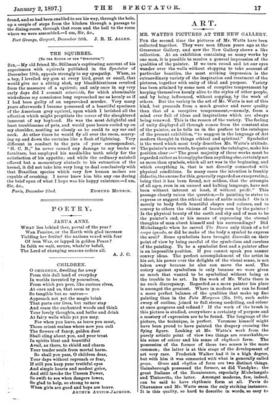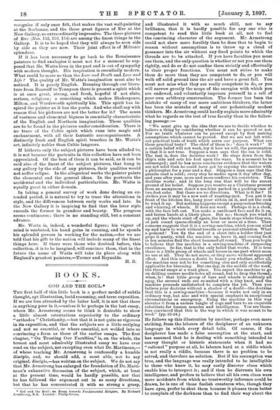ART.
MR. WATTS'S PICTURES AT THE NEW GALLERY.
Fon the second time the pictures of Mr. Watts have been collected together. They were seen fifteen years ago at the Grosvenor Gallery, and now the New Gallery shows a like collection. At an exhibition containing so many works by one man, it is possible to receive a general impression of the qualities of the painter. If we turn round and let our eyes wander over the walls without stopping to take account of particular beauties, the most striking impression is the extraordinary variety of the inspiration and treatment of the pictures, together with unity of ideal and purpose. Variety has been attained by some men of receptive temperament by keeping themselves keenly alive to the styles of other people, and by being influenced, without copying, by the work of others. But the variety in the art of Mr. Watts is not of this kind, but proceeds from a much greater and rarer quality than that of a receptive temperament,—namely, from a mind ever full of ideas and inspirations which are always being renewed. This is the reason of the variety. The feeling of unity displayed all through comes from the constant aim of the painter, as he tells us in the preface to the catalogue of the present exhibition, "to suggest in the language of Art modern thought in things ethical and spiritual." Symbolist is the word which most truly describes Mr. Watts's attitude. The painter's own words, to quote again the catalogue, make his position clear :—" The great majority of these works must be regarded rather as hieroglyphs than anything else, certainlynot as more than symbols, which all art was in the beginning, and which everything is, that is not directly connected with physical conditions. In many cases the intention is frankly didactic, the excuse for this, generally regarded as exasperating, being that it has been found, not seldom, that the attempts of all ages, even in an unused and halting language, have not been without interest at least, if without profit." This passage clearly raises the question,—Is painting to strive to express or suggest the ethical ideas of noble minds ? Or is it merely to body forth beautiful shapes and colours, and to convey to others the visions of beauty seen by the painter Is the physical beauty of the earth and sky and of man to be the painter's end, or his means of expressing the eternal thoughts of man about himself and his surroundings ? Did Michelangelo when he carved The Dawn only think of a bel corpo ignudo, or did he make of the body a symbol to express the soul Some symbolists have brought discredit on their point of view by being careful of the symbolism and careless of the painting. To be a symbolist first and a painter after is an impossible position. If you cannot speak you cannot convey ideas. The perfect accomplishment of the artist in his art, his power over the delights of the visual sense, is not taken away because he also can move the soul. The outcry against symbolism is only because we were given so much that wanted to be symbolical without being at the trouble to be art. In the work of Mr. Watts there is no such discrepancy. Regarded as a mere painter his place is amongst the greatest. Where in modern art can be found a more perfect balance of the qualities that make up fine painting than in the Fata .Aforgana (No. 109), such noble sweep of outline, joined to fall strong modelling, and colour at once gorgeous and refined ? If the work of the brush in this picture is studied, everywhere a certainty of purpose and a mastery of expression are to be found. The language of the picture, the technique, is perfect. Veronese himself might have been proud to have painted the drapery crossing the flying figure. Looking at Mr. Watts's work from the purely artistic point of view two things are remarkable,— his sense of colour and his sense of rhythmic form. The possession of the former of these two senses is the more common; the latter is at this stage of the development of art very rare. Frederick Walker had it in a high degree, but with him it was connected with what is generally called grace. Grace and rhythm of form are two distinct things. Gainsborough possessed the former, as did Vandyke ; the great Italians of the Renaissance, especially Michelangelo and Tintoretto, the latter. Amongst moderns, few, indeed, can be said to have rhythmic form at all. Pnvis de Chavannes and Mr. Watts seem the only striking instances. It is this quality, so hard to describe in words, so easy to recognise if only once felt, that makes the vast wall-painting at the Sorbonne, and the three great figures of Eve at the New Gallery, so extraordinarily impressive. The three pictures of Eve (Nos. 152, 153, 154) are among the finest things in the Gallery. It is to be hoped that they will always be seen side by side as they are now. Their joint effect is of Miltonic splendour. If it has been necessary to go back to the Renaissance painters to find analogies it must not for a moment be sup- posed that Mr. Watts lives in the past and is out of sympathy with modern thought. His inspiration is essentially modern. What could be more so than the Love and Death and Love and Life? The quality of Mr. Watts's imagination must also be noticed. It is purely English. Running through our litera- ture from Beowolf to Tennyson there is present a spirit which is at once great, strong, and fresh, hopeful if not elate, serious, religious ; a something which makes Shakespeare, Milton, and Wordsworth spiritually kin. This spirit has in- spired the painter as it has the poets. And who shall say with reason that his pictures are not the better for it P The sense of vastness and elemental bigness is essentially characteristic of the English and Northern imagination. These qualities are to be found in the pictures under consideration. There is no trace of the Celtic spirit which runs into magic and enchantment, with all their fantastic accompaniments. A distinctly fresh and English spirit breathes in Mr. Watts's art, infinitely nobler than Celtic languors.
If hitherto only the subject pictures have been alluded to, it is not because the portraits in this collection have not been appreciated. Of the best of them it can be said, as it can be said also of the finest of the subject pictures, that hung in any gallery by the side of any pictures, their qualities would not suffer eclipse. In the allegorical works the painter paints the elemental and the general ideas. In the portraits the accidental and the individual particularities. Mr. Watts is equally great in either domain.
In taking a general survey of work done during an ex- tended period, it is natural to try to trace the alterations in style, and the differences between early works and late. In the New Gallery it is inspiring to find that the later style exceeds the former in grandeur and beauty. The progress seems continuous; there is no standing still, but a constant advance.
Mr. Watts is, indeed, a wonderful figure; his vigour of mind is unabated, his hand gains in cunning, and he spends his splendid powers in working for the nation,—for we are told that his gift to the nation will include many of the finest things here. If there were those who doubted before, this collection, it is to be imagined, will convince them, that in the future the name of Watts will take its place along with England's greatest painters,—Turner and Reynolds. H. S.















































 Previous page
Previous page